
Introduction to THE AMERICANS WITH DISABILITIES ACT
| The Americans with Disabilities Act (ADA) ensures equal opportunity for persons with disabilities in employment, State and local government services, businesses that are public accommodations or commercial facilities, and in transportation. The ADA also mandates the establishment of telephone relay services for people who use TTYs (teletypewriters, also known as TDDs or telecommunications devices for deaf persons). Title I of the ADA prohibits discrimination against persons with disabilities in employment by businesses having 15 or more employees, or by State and local governments. Title I with respect to private employers is enforced by the Equal Employment Opportunity Commission (EEOC). Title II of the ADA prohibits discrimination against persons with disabilities in State and local government services, programs, and activities. All programs, services, and activities of State or local governments are covered. These include public education and social service programs, State legislatures and courts, town meetings, police and fire departments, motor vehicle licensing, employment services, and public transportation programs. State and local governments must operate their programs so that, when viewed in their entirety, they are readily accessible to and usable by people with disabilities. They must provide programs and services in an integrated setting, unless separate or different measures are necessary to ensure equal opportunity, and must eliminate unnecessary eligibility standards or rules that deny individuals with disabilities an equal opportunity to enjoy their programs or services. State and local governments must also make reasonable modifications in policies, practices, and procedures and provide effective communication through the use of auxiliary aids and services when necessary to ensure equal access for individuals with disabilities, unless an undue burden or fundamental alteration would result. When State or local governments design and construct new facilities, or alter existing facilities, they must do so in accordance with standards for accessible design adopted under the ADA. Title II (other than transportation) is enforced by the U.S. Department of Justice (DOJ). The U.S. Department of Transportation enforces the provisions of title II relating to public transportation services. Title III of the ADA prohibits discrimination against persons with disabilities in places of public accommodation and commercial facilities. Places of public accommodation include over 6 million privately owned business establishments of all sizes such as restaurants, hotels, theaters, convention centers, doctors offices, retail stores, museums, libraries, private schools, health spas, and day care centers. Commercial facilities are businesses whose operations affect commerce, such as office buildings, factories, and warehouses. Public accommodations must: provide goods and services in an integrated setting, unless separate or different measures are necessary to ensure equal opportunity; eliminate unnecessary eligibility standards or rules that deny individuals with disabilities an equal opportunity to enjoy the goods and services of a place of public accommodation; and make reasonable modifications in policies, practices and procedures that deny equal access to individuals with disabilities, unless a fundamental alteration would result in the nature of the goods and services provided. They must also ensure effective communication through the use of auxiliary aids and services when necessary, unless an undue burden or fundamental alteration would result. They must remove architectural and structural communication barriers in existing facilities where readily achievable, and provide goods and services through alternative measures when removal of barriers is not readily achievable. When public accommodations or commercial facilities design and construct new facilities, or alter existing facilities, they must do so in accordance with the Standards for Accessible Design. Title III is enforced by the U.S. Department of Justice. Title IV of the ADA mandates that telephone companies offer TTY/telephone relay services to enable individuals who use TTY's. For information on how to contact Federal agencies with ADA responsibilities, see ADA Information Services. |
The ADA and Businesses
Removing Barriers In Existing Facilities |
|
|
|
Many business facilities were built with features that do not accommodate people with disabilities, including people who use wheelchairs. This lack of accessibility makes it impossible for many people with disabilities to take part in everyday activities such as going to work, eating in a restaurant, or shopping in a store. The ADA recognizes that, for people with disabilities to participate in the everyday activities in their communities, they need to have access to employment as well as to the goods and services provided by businesses. |

|
To improve access, the ADA established both requirements for removing barriers in existing facilities and the ADA Standards for Accessible Design for new construction and alterations. In existing facilities, where retrofitting may be expensive, the requirement to provide access is less stringent than it is in new construction, where accessibility can be incorporated in the initial stages of design and construction without a significant increase in cost. If you own or operate a business that serves the public you must remove physical barriers when "readily achievable," which means easily accomplishable without much difficulty or expense. The "readily achievable" requirement is based on the size and resources of the business. So larger businesses with more resources are expected to take a more active role in removing barriers than small businesses. The ADA also recognizes that economic conditions vary. When a business has resources to remove barriers, it is expected to do so; but when profits are low, barrier removal may be reduced or delayed. Barrier removal is an ongoing obligation -- you are expected to remove barriers in the future as resources become available. |
|
|
In evaluating what barriers need to be removed, a business should look to the ADA Standards for Accessible Design as a guide. These standards are part of the ADA Title III regulations. Seeking input from people with disabilities in your community can also be an important and valuable part of the barrier removal process, because they can help identify barriers in your business and offer advice on what solutions may work. |
New Construction, Alterations and Additions |
|

|
New Construction All newly constructed business buildings or facilities must be readily accessible to and usable by individuals with disabilities. This means that new buildings or facilities must be built in strict compliance with the ADA Standards for Accessible Design. The ADA Standards are comprehensive and require accessibility to most areas and features found in buildings or facilities. The requirements for work areas are more limited than those for public and common use areas. |
 |
Alterations If an alteration to a business building or facility is begun after January 26, 1992, the areas or elements that are altered must be readily accessible to and usable by individuals with disabilities in accordance with the ADA Standards for Accessible Design to the maximum extent feasible. When an alteration is made to a "primary function area," the alteration must be done in compliance with the ADA Standards for Accessible Design, but there must also be an accessible path of travel from the altered area to the accessible entrance. The "path of travel" requirement includes an accessible route to the altered area and the bathrooms, telephones, and drinking fountains serving the area. Alterations to provide an accessible path of travel are required to the extent that they are not "disproportionate" to the original alteration, that is, to the extent that the added accessibility costs do not exceed 20 percent of the cost of the original alteration to the primary function area. A primary function area is any area where a major activity takes place. It includes both the customer services areas and work areas and the public and common use areas in places of public accommodation. It includes all offices and work areas in commercial facilities. It does not include mechanical rooms, boiler rooms, supply storage rooms, employee lounges or locker rooms, janitorial closets, entrances, corridors, or restrooms. |
|
Additions |
Policies, Practices and Procedures |
|
 |
|
 |
Businesses offering goods and services to the public must provide auxiliary aids and services when needed to communicate effectively with people who have hearing, vision, or speech impairments, unless providing the aid or service would be an undue burden or a fundamental alteration to the nature of the business. Auxiliary aids and services include reading written information to a person who is blind or who has low vision or providing large print, audiotape or Braille; and using written notes, sign language interpreters or using captioning to communicate with a person who is deaf, hard of hearing or who has a speech disability. |
To Learn More...
The Americans with Disabilities Act authorizes the Department of Justice (the Department) to provide technical assistance to individuals and entities that have rights or responsibilities under the Act. This document provides informal guidance to assist you in understanding the ADA and the Department's regulations.
This guidance document is not intended to be a final agency action, has no legally binding effect, and may be rescinded or modified in the Department's complete discretion, in accordance with applicable laws. The Department's guidance documents, including this guidance, do not establish legally enforceable responsibilities beyond what is required by the terms of the applicable statutes, regulations, or binding judicial precedent.
last update February 22, 2002

